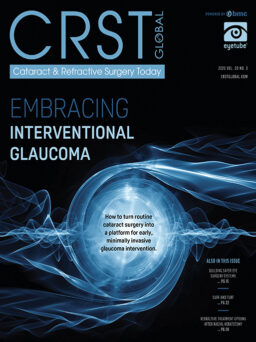1. Of which of your accomplishments in medicine are you most proud?
I am proud to have founded in 2005 the first keratoconus center in Turkey at the Dünya Eye Hospital, where I have been following my passion for more than 17 years. Dünya Eye Hospital has clinics in several European countries and is considered among Turkish ophthalmologists to be the biggest eye hospital group in Turkey. The hospital is known for its professionalism and excellence, for acquiring the newest technologies, and for working with the most experienced surgeons.
2. You were the first surgeon to perform corneal collagen crosslinking (CXL) in Turkey. How have your methods for the procedure evolved since your earliest CXL patients?
When I first started CXL in 2004, I selected only patients with high-grade keratoconus. I knew that these patients would have to be treated with keratoplasty if they were not treated with CXL. I treated one eye (the eye in the worst condition) and left the other one untouched for comparison during follow-up. My 2009 study of 19 patients found that, 6 months postoperatively, the treated eyes showed signs of stopping progression, and the untreated eyes continued to progress.1 Additionally, the treated eyes demonstrated signs of refractive correction, and many patients requested surgery on their other eye.
Regarding methods, unfortunately, the first complication I faced in two early cases was late reepithelialization, which occurred 11 days postoperatively. I used to remove the central 8 mm of the corneal epithelium; however, after learning that riboflavin spreads twice as fast horizontally as it does vertically, I began to remove the epithelium in three 1-mm-thick bands and then join them in the inferior cornea. Epithelialization is complete in approximately 2 days. Since I adopted this approach, late reepithelialization has not occurred.
Initially, I aimed to attain a 400-μm thickness of the stromal bed, which means that the corneal thickness had to be a minimum of 450 μm preoperatively. However, with hypotonic riboflavin solutions helping to thicken the stroma, today I can perform ultraviolet treatments on thinner corneas.
3. What is the quadruple procedure, and what pearls can you share for achieving success with it?
The quadruple procedure is a combination of intrastromal corneal ring segment (ICRS) implantation, CXL, a phakic toric IOL, and topography-guided laser treatment. The Keraring (Mediphacos) is an effective method for improving UCVA and BCVA in keratoconic eyes. The Keraring’s maximum effectiveness, depending on corneal thickness, is about 7.00 D. The inhibiting effect of the ICRS on keratoconus progression is still unclear. CXL has been shown to stop the progression of keratoconus. Maximum ablation depth for transepithelial topography-guided laser treatment is 50 μm in a 5.5-mm optical zone, and the maximum effect is 5.00 D. CXL followed by toric phakic IOL implantation as a two-stage procedure has been reported.2,3 Although the toric phakic IOL can correct high spherocylindrical refractive error, the limitation is that phakic IOLs cannot effectively treat irregular astigmatism, and the expected effect of CXL would be a maximum decrease of 2.00 D in irregularity of the cornea.4 It takes 6 months for the cornea to stabilize after ICRS implantation. We wait at least 6 months before continuing with the other procedures. After CXL and ICRS implantation, we proceed with topography-guided laser treatment and phakic IOL implantation.
4. What is the focus of your current research?
My colleagues and I are screening children for the early stages of keratoconus. To date, using the Orbscan II (Bausch + Lomb), we have screened 1,800 children between the ages of 11 and 17 years. We have performed CXL on three children and continue to follow eight children with forme fruste keratoconus every 3 months.
5. What advice do you have for ophthalmologists new to practice?
New ophthalmologists must stay current with the research on emerging technologies and methods. I strongly recommend attending international ophthalmic meetings.
- Coskunseven E, Jankov MR 2nd, Hafezi F. Contralateral eye study of corneal collagen cross-linking with riboflavin and UVA irradiation in patients with keratoconus. J Refract Surg. 2009;25(4):371-376.
- Kymionis GD, Grentzelos MA, Karavitaki AE, et al. Combined corneal collagen cross-linking and posterior chamber toric implantable collamer lens implantation for keratoconus. Ophthalmic Surg Lasers Imaging. 2011;42 online:e22-25.
- Güell JL, Morral M, Malecaze F, et al. Collagen crosslinking and toric iris-claw phakic intraocular lens for myopic astigmatism in progressive mild to moderate keratoconus. J Cataract Refract Surg. 2012;38(3):475-484.
- Coskunseven E. Collagen copolymer toric phakic intraocular lens for residual myopic astigmatism after intrastromal corneal ring segment implantation and corneal collagen crosslinking in a 3-stage procedure for keratoconus. J Cataract Refract Surg. In press.




